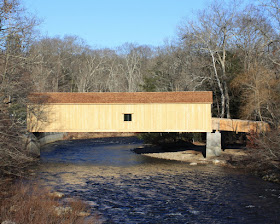That's not a typo. Cornwall Bridge is actually within the town of Cornwall Bridge. It carries Route 7 over the Housatonic, and is just a few miles south of West Cornwall Covered Bridge, the bridge from yesterday's post.
The Cornwall Bridge is a six span, open spandrel concrete arch bridge. It really sounds like I know what I'm talking about when I write that. It's a huge bridge, but crossing it by car, there is no clue as to its size or beauty. You have to stop the car and look over the side -- or drive down the steep hill past the tourist shop and the church and just be bedazzled.
So, lesson learned. If you're going to drive a couple of hours to get someplace beautiful, and you have a full slate of bridges to photograph as well as a hike, make sure you are _prepared_. I didn't prepare then.
Maybe lesson not learned. I rode my bike five miles in the wrong direction this morning because I didn't check my map carefully enough. Late for work, too.
 If you plan to visit the Cornwall Bridge in Cornwall Bridge, you can park at the foot of the bridge itself, as the creepy pickup truck with its lights on was doing in the second picture. What was up with that. Or, you can park up top at the trailhead to the Mohawk Trail. Which I did.
If you plan to visit the Cornwall Bridge in Cornwall Bridge, you can park at the foot of the bridge itself, as the creepy pickup truck with its lights on was doing in the second picture. What was up with that. Or, you can park up top at the trailhead to the Mohawk Trail. Which I did.The Mohawk Trail climbs Breadloaf Mountain and joins at the summit to the Appalachian Trail. It's entirely possible to take the trail from here, all the way south to Bulls Bridge and then leave Connecticut at that point for New York, keep hiking, and come eventually to the Bear Mountain Suspension Bridge over the Hudson. I would love to do that someday -- just hike the Appalachian Trail for a few days.
This far south, the Berkshires aren't really a mountain range; more a series of tall hills, yet the hike is fairly strenuous. It's well marked, but don't expect the paths to be to the well-trod level of the ones up at Shenipsit State Park. The trail is steep and rocky and you will be grabbing at trees to help get up and back down again.
 |
| Summit of Breadloaf Mountain |
































